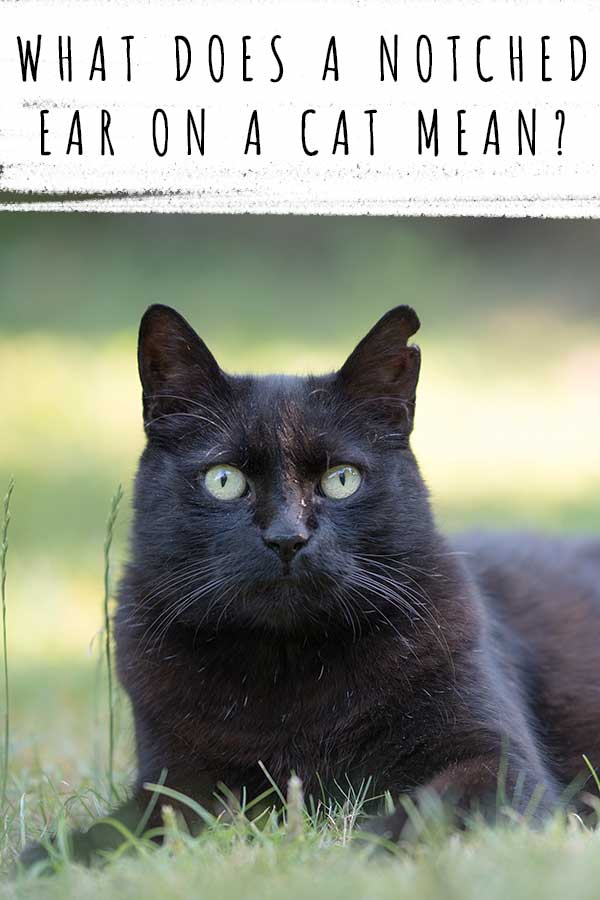
What does a notched ear on a cat mean? There are several reasons why a cat might appear to have a notch missing from one or both of their ears:
- They belong to a breed with curled or folded ears
- Their ear has been damaged in a fight
- Part of their ear has been amputated to treat a disease
- Or they have been treated in a trap-neuter-release program
In this guide, I’ll take a closer look at each of those reasons in turn and the clues for recognizing each one of them on sight.
Cats With Naturally Odd Shaped Ears
Does that cat in the distance look like both of their ears have the tips missing? Look again – they might just be folded over or curled back.
The pinna (plural pinnae) is the visible bit of a cat’s ear – the bit which stands out from the head. In American Curl cats, the pinnae curl backwards at the top. And on Scottish and Highland Fold cats they fold forwards at the top.
In both cases these unusual ears are caused by a genetic mutation. The mutation started in a single individual, and breeders carefully propagated it so that it occurs in the whole pedigree.
At first glance, it gives the impression of their ears having a notch missing from the top – especially if you haven’t seen it before.
How to spot it:
Notched Cats Ears Caused By Damage In A Fight
The next reason a cat might have a notched ear is if they have been fighting and sustained an injury.
Cats fight to claim and defend territory, and when a tom cat makes an unwanted amorous advance on a female. During fights, one cat may take a notch out of the other’s ear with their teeth, or claws.
When this happens, unfortunately the wound cannot usually be stitched or reconstructed. A vet will normally clean the wound, and advise their owner to let it heal in its own time. The missing notch will remain as a legacy of their past misadventures!
How to spot it:
Cat Ear Notches Caused By Amputation
Occasionally a cat may need to have part of their ear amputated due to disease. An example of this is if sun damage causes cancerous tumors on the skin of the ear.
This is most likely to be a problem for hairless cats. And cats with very fine, short hair, which leaves the skin exposed to sun damage.
A vet will often recommend removing most or all of the pinna, to make sure a wide margin is achieved around the tumor and it can’t spread further. The best way to protect against this is to limit your cat’s exposure to intense sunshine.
How to spot it:

The TNR Ear Notch
Finally, a free-roaming or feral cat might have a notch missing from their ear to show that they have been neutered as part of a trap-neuter-release (TNR) program.
Non-profits run TNR programs to control the size of feral cats populations, and reduce antisocial behaviors related to mating, such as noisy fights.
Adult feral cats are caught in humane traps, neutered by a licensed vet, and then released again. They are released because adult feral cats don’t adapt well to living with people, and can’t easily be rehomed.
Whilst under general anesthetic for the spay or neuter procedure, the vet clips a bit from one ear, cleans the wound, and administers a long-lasting antibiotic.
How to spot it:
- The notch is neat – either a straight line across the top of one ear, or a triangle from the side of the ear like in the pictures accompanying this article.
Pros And Cons Of The Feral Cat Ear Notch
Neutering feral cats and notching their ear to clearly identify them seems like an honorable endeavor, but it’s actually a pretty controversial practice.
On the one hand:
- It prevents feral populations getting bigger.
- The TNR ear notch tells animal control officers that a cat is fixed, so they don’t try to capture it again unnecessarily.
- A long term study of a large TNR population in Florida found reduced overall population size and a decrease in retroviral disease prevalence.
But on the other hand:
- Free roaming cats are still an invasive species which upset native ecosystems.
- Once released, TNR cats are still a reservoir for disease, which they can transmit to pets cats.
- And they kill hundreds of millions of birds in the USA every year, making a substantial contribution to bird population decline.
So, TNR schemes remain controversial. The most recent school of thought is that they have a role to place, but they are not enough by themselves.
More effort is also needed to achieve suitable adoptions, and deliver community education.
Ten days’ ago, a quite desperate cat showed her face. I have fed two adorable strays for the last five years, yet despite my endless endeavours neither wishes to become my permanent residents.
This third cat, the ever-so sorry newcomer was scooped up by myself, checked and placed in a spare room with all she required. She slept solidly for three days. By day five, she began to fully interact with me. I am only a few more days away from now gaining her trust.
Yes, she has a neatly punched ear, which I only just found the meaning of on here. This tiny cat was in such a delapidated state when I found her. She was shivering so much, that she coudn’t eat without losing most of her food. I am confident that she will stay.
So if you do come across a clipped-ear moggy, have a go and at least feed it. There is a chance that it might have had enough of the feral life.
And when my new pet goes to the vets in the coming days to be checked over, I bet she will cost me a small fortune, Ian 2nd April 2023 🙂
As a very quick udate, I was just about to go to bed. I had a peep throgh the door to her room. Fast asleep, but awoke when she saw me. I picked her up and sat down for a few moments with my other two. They were simply Very curious and very nice. I let the introductions go on for a few minutes. Not at all stressful. I can’t wait to get some ear powder tomorrow to help her slightly itchy ear, and book her in at the vets. The improvement in one week from a tatty moggy, to half-cat with a little weight gain is incredible.
I got a cat like this from Foster care. She was about a year old. Her Foster parents had to slowly gain her trust with treats but even then she didn’t like to come to people for long. For the first year I had her she would come for a quick pet then go back to hiding. She also used to try to escape often.
Now just a few years later, she is the cuddliest cat I’ve ever had. She loves people. She sleeps under the covers by my belly and she gives gentle nibbles or puts her paw on our cheek when we aren’t paying her any attention. She never tries to go outside anymore and she is just pure absolute love. It’s hard to believe now that she was once afraid of people!